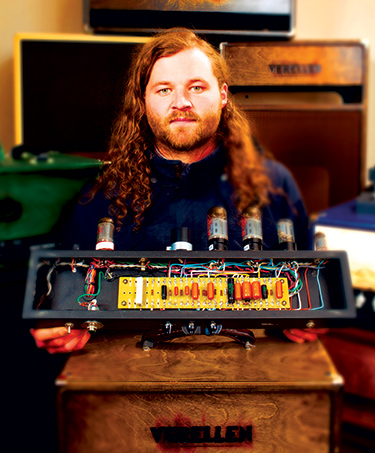For instance, civil and environmental engineering Professor Mark Benjamin discovered a way to make water filters better and more efficient by utilizing aluminum oxide particles. While the technology is still in the lab, success could be fundamental for global health. C4C provided a Gap Fund award in 2008 that helped Benjamin continue proof-of-concept work essential to demonstrating the technology’s viability in the field; commercial application is still down the road but nearer as a result. And given that clean drinking water is a desperate need for hundreds of millions of people around the world, an effective filtering technology could be both a commercial and a humanitarian boon.
Meanwhile, other UW researchers are working on technologies minimizing the amount of plastic needed to make insulated cups; improving diagnosis and treatment of atrial fibrillation; refining gene-specific cancer drugs; extending the life of touch-screens; helping airplanes save fuel by following more efficient navigation routes; and providing better diagnostic images of the arterial plaque that can cause strokes.
In one example of how appealing entrepreneurship can be, electrical engineering Professor Shwetak Patel’s energy-monitoring systems firm, called Zensi, was sold to network equipment-maker Belkin last April. Patel is also currently commercializing other research around ultra-long-life sensor batteries—which are so low-power they could run for up to 50 years.

From his Fremont shop, Ben Verellen, ’08, is working on commercial production of his Verellen Amps.
Not every UW-born business is built on new technology. Former engineering student Ben Verellen, ’08, in fact, turned back the clock when he posed a question to one of his electrical engineering professors while at the U: How do you design and build vacuum-tube amplifiers?
But wait—aren’t we in the digital era? Why would anyone want to go back to the technologies Jimi Hendrix used 40 years ago?
“Tube amps just sound better,” explains Verellen, who is a musician himself. (Verellen is guitarist and singer for the band Helms Alee.) “There’s more character to the sound. And if you’re looking for distortion and feedback, transistors just don’t do the trick at all.”
Verellen convinced engineering professor Brian Otis, ’99, to sponsor a project in which he created circuit designs for a simple tube amplifier. After that he studied various production and design techniques, and three years later, he is the founder and president of Verellen Amplifiers, a small, Fremont-based custom-amplifier maker that has sold more than 200 amps. The basic model, “Meatsmoke,” looks like what you’d see if you opened the back of a 1960s-era television.
While an amplifier may seem like a straightforward artifact to the layperson, Verellen says design parameters are practically infinite.
“You can change this or that, or the other thing, and every single design item has a sonic consequence,” he explains.
Verellen’s are custom amps used primarily by underground punk rock bands, though one is owned by a member of the Foo Fighters, a high-profile Seattle band whose genesis traces back to Nirvana. Verellen is moving from custom work to a production model he hopes will take his company to the next level of business viability.
Rhoads is quick to point out that, aside from helping UW researchers achieve the thrill of entrepreneurship, bringing in revenue and helping make human life better, UW-born startups create jobs and boost the economy in Washington state. Verellen employs one production assembler for his amps; Magic Wheels has a staff of 12; dozens of researchers work on the next new drug at the Amgen labs downtown. While Microsoft remains the birthplace-hub of the greatest number of technology startups in the state, the UW is second, and that count doesn’t include biotech. All those companies are drawing in venture capital (which often comes from out of state) and employing local residents who may or may not include their creators.
Etzioni, for one, no longer has any association with Farecast. But he certainly is proud to be known as the initiator of the company. “I tell people, that’s my baby, every chance I get.” He’s currently involved in several other projects not yet ready for public visibility, and is above all gratified that his position at the UW enabled him to answer such an arcane question as whether airfares can be predicted.
“The obligation of venture capitalists is to make money. My professional obligation is to satisfy my curiosity.
“Curiosity-driven research—it’s a wonderful thing.”
From research to revenue
According to the Center for Commercialization, more than 250 companies have been started by UW students and faculty or have launched using UW technology. Here are a few:
In 2003, doctoral student Aaron Feaver co-founded EnerG2, a company that develops materials such as carbon monoliths and nanocomposites for the purposes of storing gases such as hydrogen and methane, and for goals such as the more efficient operation of solar cells.
In 2002, Seattle Sensor Systems stepped up to plug a gap in national security by introducing the first portable biosensor for chemicals, toxins and biological warfare agents. Technology for the systems came out of the UW’s Surface Plasmon Resonance laboratory, and the company’s founders include UW professors and researchers, notably the primary scientific adviser, Clement Furlong, a research professor of genome sciences and of medicine.
Greg Branch and Krishna Nadella—then Ph.D. candidates in materials science—founded MicroGreen Polymers in 2002. The company’s mission is to develop and commercialize environmentally sound plastics technologies that are economically attractive to the plastics industry. In May, MicroGreen announced it had raised $6.9 million in funding to expand commercial production capabilities.
